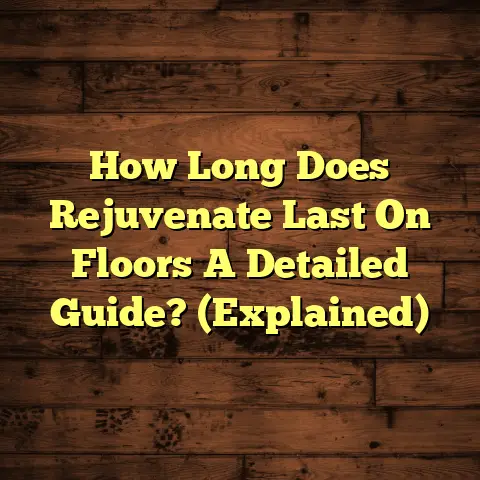Roomba: Carpet to Hardwood? (2 Must-Knows!)
Imagine this: You’ve just invested in a state-of-the-art Roomba, a robotic vacuum that promises to revolutionize your cleaning routine.
It glides effortlessly across your plush, inviting carpet, sucking up pet hair and dust with a grace that seems almost magical.
But then, you decide to transition to a sleek, modern
hardwood floor.
Suddenly, you’re faced with a dilemma.
Will your beloved Roomba adapt seamlessly to this new terrain, or will it stumble, leaving scratches in its wake?
Can it handle the transition between these two very different surfaces without jeopardizing its performance?
The stakes are high, and the answers may surprise you.
As a flooring contractor, I’ve seen firsthand how homeowners struggle with maintaining different floor types.
And the rise of robotic vacuums like the Roomba has added another layer to the equation.
Let’s dive into what you really need to know about using your Roomba on both carpet and hardwood.
Section 1: The Evolution of Roomba Technology
Remember the first Roomba?
It was a simple, almost
clunky device, bumping around and hoping for the best.
Now, we have Roombas with advanced mapping, self- emptying bins, and even models that mop!
The evolution has been incredible.
iRobot, the company behind Roomba, has continuously innovated, focusing on improving performance across various surfaces.
Early models struggled with transitions between carpet and hardwood, often getting stuck or not cleaning effectively.
But newer models are equipped with features like automatic height adjustment and improved sensors.
These advancements allow them to adapt much better to different floor types.
The type of flooring definitely plays a huge role in how
well a Roomba performs.
Think about it.
A thick shag carpet requires a completely different approach than a delicate hardwood floor.
Section 2: Understanding Carpet vs. Hardwood
Let’s talk about carpet.
It’s soft, absorbs sound, and can
be very cozy.
But it’s also a magnet for dirt, dust, and
allergens.
Carpet’s texture traps particles deep within its fibers, making thorough cleaning essential.
Durability varies widely depending on the type of carpet fiber (nylon, polyester, wool, etc.) and its construction.
Maintenance involves regular vacuuming, spot cleaning, and occasional deep cleaning with a carpet cleaner.
Hardwood, on the other hand, offers a sleek, elegant look.
It’s generally easier to clean than carpet, but it’s also more susceptible to scratches and dents.
Hardwood’s smooth surface means that dust and debris tend to sit on top, rather than getting trapped.
Maintenance involves sweeping or vacuuming, followed by occasional mopping with a wood-friendly cleaner.
The differences between these surfaces significantly impact the Roomba’s cleaning process.
Carpet requires stronger suction and brush agitation to lift dirt, while hardwood needs a gentler approach to avoid damage.
Section 3: The Mechanics of Roomba’s Cleaning System
So, how does a Roomba actually work?
It’s a clever
combination of sensors, brushes, and suction.
Roombas use a variety of sensors to navigate your home.
These include:
- Cliff sensors: To prevent them from falling down stairs.
- Wall-following sensors: To clean along edges.
- Optical sensors: To track movement and map the room.
Newer models even use cameras and advanced algorithms to create detailed maps of your home.
This allows them to clean more efficiently and avoid obstacles.
The brush design is also crucial. Most Roombas have a combination of:
- Edge-sweeping brushes: To pull debris from corners and edges.
- Main brushes: To agitate dirt and lift it into the vacuum.
Some models have adjustable brush heights, which is especially important for transitioning between carpet and hardwood.
The Roomba’s sensors play a key role in detecting different floor types.
When it senses a change in surface, it can adjust its suction power and brush speed accordingly.
For example, it might increase suction on carpet and reduce brush speed on hardwood to prevent scratching.
Section 4: Must-Know #1 – Performance on Hardwood Floors
Now, let’s get to the heart of the matter: How well does a Roomba really perform on hardwood floors?
In my experience, Roombas generally do a good job of cleaning hardwood.
They’re effective at picking up dust, crumbs, and pet hair.
The key advantages are:
- Convenience: You can schedule it to clean automatically.
- Regular Cleaning: Helps prevent the buildup of dust and debris.
- Edge Cleaning: Many models do a decent job along edges and corners.
However, there are also some challenges:
- Scratching: Some Roombas can scratch delicate hardwood finishes, especially if the brushes are worn or if there’s debris trapped underneath.
- Leaving Behind Dirt: On heavily soiled areas, a Roomba might not have enough suction to pick up everything.
- Navigation Issues: Some models struggle with dark hardwood floors or rugs with dark patterns.
I’ve heard from many homeowners who have had both positive and negative experiences.
One client told me her Roomba scratched her brand new hardwood floors because she didn’t clean the wheels regularly.
Another raved about how her Roomba kept her hardwood floors spotless, saving her hours of cleaning each week.
The key is to choose the right Roomba model, maintain it properly, and be aware of its limitations.
Section 5: Must-Know #2 – Maintenance and Care
Proper maintenance is essential for optimal performance and to prevent damage to your floors.
Here are some essential maintenance tips specific to hardwood cleaning:
- Clean the Brushes Regularly: Remove hair, string, and other debris that can get tangled in the brushes.
This will prevent scratching and improve cleaning performance. - Empty the Dustbin Frequently: A full dustbin reduces suction power.
- Check the Wheels: Make sure the wheels are clean and free of debris.
This will ensure smooth movement and prevent scratching. - Replace Filters Regularly: Clean filters improve air quality and suction.
- Use the Right Cleaning Solutions (If Applicable): Some Roomba models have mopping features.
Use only cleaning solutions that are specifically designed for hardwood floors.
I’ve seen many users make common mistakes when switching between floor types.
One of the biggest is not adjusting the Roomba’s settings for different surfaces.
If you have a model with adjustable suction or brush height, make sure to adjust it accordingly.
Another mistake is using the Roomba on heavily soiled areas without pre-cleaning.
For tough messes, it’s best to spot clean first and then let the Roomba maintain the cleanliness.
Also, be mindful of rugs.
Some Roombas can get stuck on
thick rugs or rugs with tassels.
Section 6: The Future of Robotic Vacuum Technology
The future of robotic vacuum technology is bright!
I expect
to see even more advancements in the coming years.
One area of focus will be on improving versatility across various surfaces.
We’ll likely see Roombas with:
- More Advanced Sensors: To better detect and adapt to different floor types.
- Improved Brush Designs: To effectively clean both carpet and hardwood without causing damage.
- AI-Powered Cleaning: To learn your cleaning habits and customize its cleaning routine.
- Better Navigation: To avoid obstacles and clean more efficiently.
I also predict that we’ll see more Roombas with integrated mopping features.
These models will be able to vacuum and mop your floors in one pass, saving you even more time and effort.
Consumer trends are also driving innovation.
People want convenient, automated cleaning solutions that can handle a variety of flooring types.
As robotic vacuum technology continues to evolve, I believe they’ll become even more indispensable in our homes.
Conclusion: The Final Verdict
So, can a Roomba handle the transition from carpet to
hardwood?
The answer is yes, but with some caveats.
It’s important to understand both your flooring type and your Roomba’s capabilities.
Choose the right model, maintain it properly, and be aware of its limitations.
By following these tips, you can enjoy the convenience of a robotic vacuum without damaging your floors.
The advancements in technology are constantly changing the landscape of home cleaning.
It’s exciting to see how these devices will continue to evolve and make our lives easier.
Call to Action:
I’d love to hear about your experiences with Roombas on different floor types!
Share your tips and tricks in the comments below.
And stay tuned for future articles where I’ll delve deeper into robotic cleaning technology and home maintenance tips.





